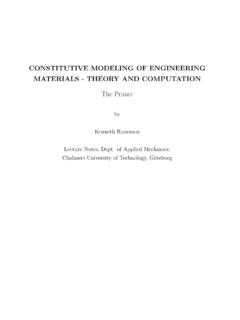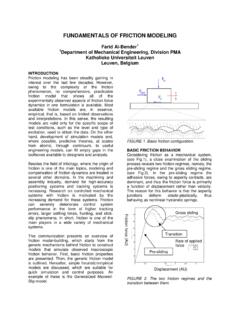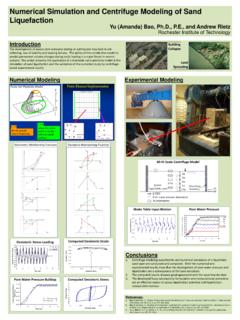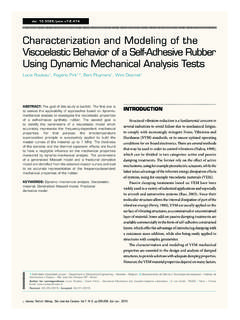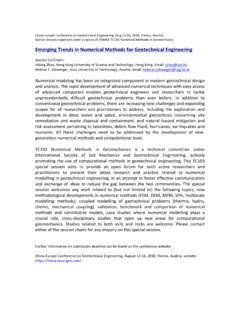Transcription of Use of CFD in Design: A Tutorial - Porter McGuffie, Inc
1 Use of cfd in design : A TutorialSean M. McGuffie, A. Porter , T. HirstContents1 About the About the Authors ..42 What is CFD? .. History of CFD .. Why use CFD? .. Common Terminology and Abbreviations .. 143 Lagrangian vs Eulerian Formulations .. Navier Stokes Equations .. Overview of Solution Methods .. 194 The CFD Modeling Example 1: Mixing Tank .. Understand the Physics .. Define Computational Volume .. Create the Computational Grid .. Select Physics .. Apply Boundary Conditions .. Initialize Model .. Solve .. 345 Example 2: Flow Between Parallel Create a Computational Grid .. Select Physics .. Apply Boundary Conditions .. Initialize Model .. Solve .. Results .. 516 Introduction to What is Turbulence? .. Can CFD Handle Turbulence?
2 547 Example 3: Waste Heat Boiler Understanding the Physics .. Select the Computational Volume .. Create the Computational Grid .. Selection of Physics Models .. Applying Boundary Conditions .. Initializing the Model .. Solve .. 728 Advanced DES and LES Turbulence Modeling .. Porous Media .. Radiation .. Multi-Component Flows .. 1069 Summary107 USE OF CFD IN DESIGN1 ABOUT THE PRESENTATION1 About the PresentationThis Tutorial was developed at the request of the ASME design and Analysis Committee as ameans of providing information regarding the state of the art in computational fluid dynamics(CFD). Employees of Porter McGuffie, Inc. (PMI), specifically, Mike Porter , Sean McGuffie, andTommy Hirst developed this Tutorial . Sean and Tommy extend their gratitude to Mike for provid-ing the resources that made its development strove to make this Tutorial as software-independent as possible.
3 Instead, we worked toincorporate fundamental concepts, using models available in most commercial CFD codes. For theexamples included in this Tutorial , we used Star-CCM+, a product developed by CD-Adapco. Onthe flash drive supplied to you are electronic copies of the course materials, including: PowerPoint presentation PDF course manual Selection of model filesAdapco has offered a free one (1) month trial license of their software if you desire to play withthe model files. Attendees may obtain a no-cost 30 day license to use STAR-CCM+ for partic-ipation in this event (subject to export control compliance and end user license agreement). Toobtain your license, contact Eric Volpenhein of CD-adapco ; (513)574-8333].In the manual, PMI has included basic instruction sets for most of the software demonstrations thatwill occur. These instructions are written in standard software use format. Take the Star-CCM+Commands illustrated below:Star-CCM+ Commands1.
4 File New Simulation OK2. File Import Volume Mesh items are indicated within boxes similar to those above, they are commands that will beissued during the Tutorial . Thus if attendees would like to perform the same actions as shown inthe software, they may do so by following the commands within the Star-CCM+ Commands particular command directs the user to approach the File menu, then select a New Simulationand click OK in Step 1. Step 2 is also using the File menu and performing the action of importinga mesh. For sub-menus within Star-CCM+, the command box will be indented to indicate goingfurther within any particular menu. Most commands will involve a left click action to necessary right clicks or other actions are generally specified encourage the participants to take advantage of the trial software and sample models provided;it is only through practice modeling that you can understand the concepts presented have hours to cover the information contained in thousands of pages of introductory such, we re going to make your head spin at the rate that information comes to you.
5 And we3 of 110 USE OF CFD IN DESIGN2 INTRODUCTIONare just going to touch the surface. You won t walk out of this Tutorial feeling like you can tackleany CFD problem with zero difficulty. But, you should walk out with fuller knowledge of what spossible, potential pitfalls and a better understanding of how complex problems can be. PMI willbe at the conference until noon on Thursday, feel free to seek us out with questions that mightoccur to you following today s About the AuthorsSean M. McGuffie, - Sean is a Senior Engineer with PMI. He has beenperforming CFD for the past 16 years and is familiar with most commercial CFD packages. Seanis the lead author for the Tutorial and is responsible for the following sections: General Procedures for CFD Analyses Modeling Turbulence Example 3 - CFD Analysis of a Waste Heat Boiler Ferrule System Advanced TopicsTommy T. Hirst - Tommy is currently a graduate student at the Universityof Kansas pursuing a Masters in Mechanical Engineering with a focus on finite element analysisand continuum mechanics.
6 Tommy has been working with PMI on CFD and FEA problems forthe past year. Tommy is a secondary author of this Tutorial and will be presenting the followingsections: Mathematics Example 2 - Flow Between Parallel PlatesMichael A. Porter , - Mike is the principal engineer of PMI, an ASME fellow and a long time practitioner of numerical simulations. His participation in this Tutorial islimited to: Why Perform CFD?2 IntroductionRecent advances in computational resources have made the use of computational fluid dynamics(CFD) to support industrial design activities more commonplace. While large and small organiza-tions have adopted the technology, it is still considered magic by most engineers. The purposeof this Tutorial is to provide the design engineer with an understanding behind the fundamentalconcepts related to successfully performing CFD analyses, and to discuss how they can be incor-porated into design Tutorial is organized into two sessions.
7 The first session will provide an overview of the CFDmodeling process, including: What is CFD? Why perform CFD? A general outline of the Navier-Stokes equations and their solution, and4 of 110 USE OF CFD IN DESIGN2 INTRODUCTION An overview of the general steps required for all CFD analyses (with mixer example)These preliminary concepts will then be reinforced through the solution of a simple CFD the solution of the problem, the concepts of establishing solution monitors and using themto monitor convergence will be second session will cover more advanced concepts, including: General discussion of turbulence, Numerical methods for turbulence modeling, Example of turbulence modeling with a waste heat boiler (WHB) ferrule assembly, and A general discussion of more advanced topicsDuring the Tutorial , several industrial examples will be shown to demonstrate the What is CFD?Computational fluid dynamics, commonly referred to as CFD, is the solution of a system of partialdifferential equations (PDEs) to determine a numerical solution of a problem.
8 The dictionary defi-nition of computational fluid dynamics is the prediction of the behavior of fluids and of the effectsof fluid motion past objects by numerical methods rather than model experiments [1]. In generalthe solution of the PDEs of a particular flow physics are laboriously difficult or nearly impossibleand cannot be solved analytically except in special cases [2]. This allows numerical experimentsto be performed without the need for full-blown experimental results on a problem by problem , several different mathematical formulations are used to solve a system of PDEs. Theseinclude, but are not limited to:1. Finite difference method (FDM)2. Finite element method (FEM)3. Finite volume method (FVM)Currently the finite volume method is the method of choice for implementation within the majorityof commercially available software packages. However, other methods have been shown to achieveaccurate results.
9 Finite volume methods (and all numerical methods) are used to create an approx-imation using discretizations of the problem physics [2].CFD is useful and has become growingly popular for some of the following reasons [3]: CFD allows numerical simulation of fluid flows, the results for which are available for studyeven after the analysis is over. CFD allows observation of flow properties without disturbing the flow itself, which is notalways possible with conventional measuring instruments. CFD allows observation of flow properties at locations which may not be accessible to mea-suring instruments. CFD can be used as a qualitative tool for discarding (or narrowing down the choices between)various of 110 USE OF CFD IN DESIGN2 History of CFDThe growth of CFD, as currently recognized, began in the 1970 s at the same time as the rise ofthe computer, the 1970 s. Computational fluid technologies has paralleled that of computationaltechnologies.
10 As computational power has grown so has CFDs capability to deal with extremecomplexities. In the 1980 s the introduction of both 2D and 3D models began as well as the questto conquer the Navier-Stokes equations, considered the holy grail of CFD modeling at the time. Enhancements of CFD were spurred on by aviation, aerospace, nautical, and development ofturbo-machinery [4].Along with the development of CFD came the need to develop more complex algorithms of gridgeneration, also referred to as mesh generation. Meshing technology began with simple the need for more complex geometries became apparent, so did the schemes to create meshes forthem [4]. Mesh generation has evolved to include non-matching grids ( , cells do not align) andcan now take many forms: tetrahedral, prism-based, hexahedral, etc. While meshing technologybegan with the use of the tetrahedron, as they are easier to create, research has shown that the useof prism or hex grids should be used in viscous flow regions [4].

